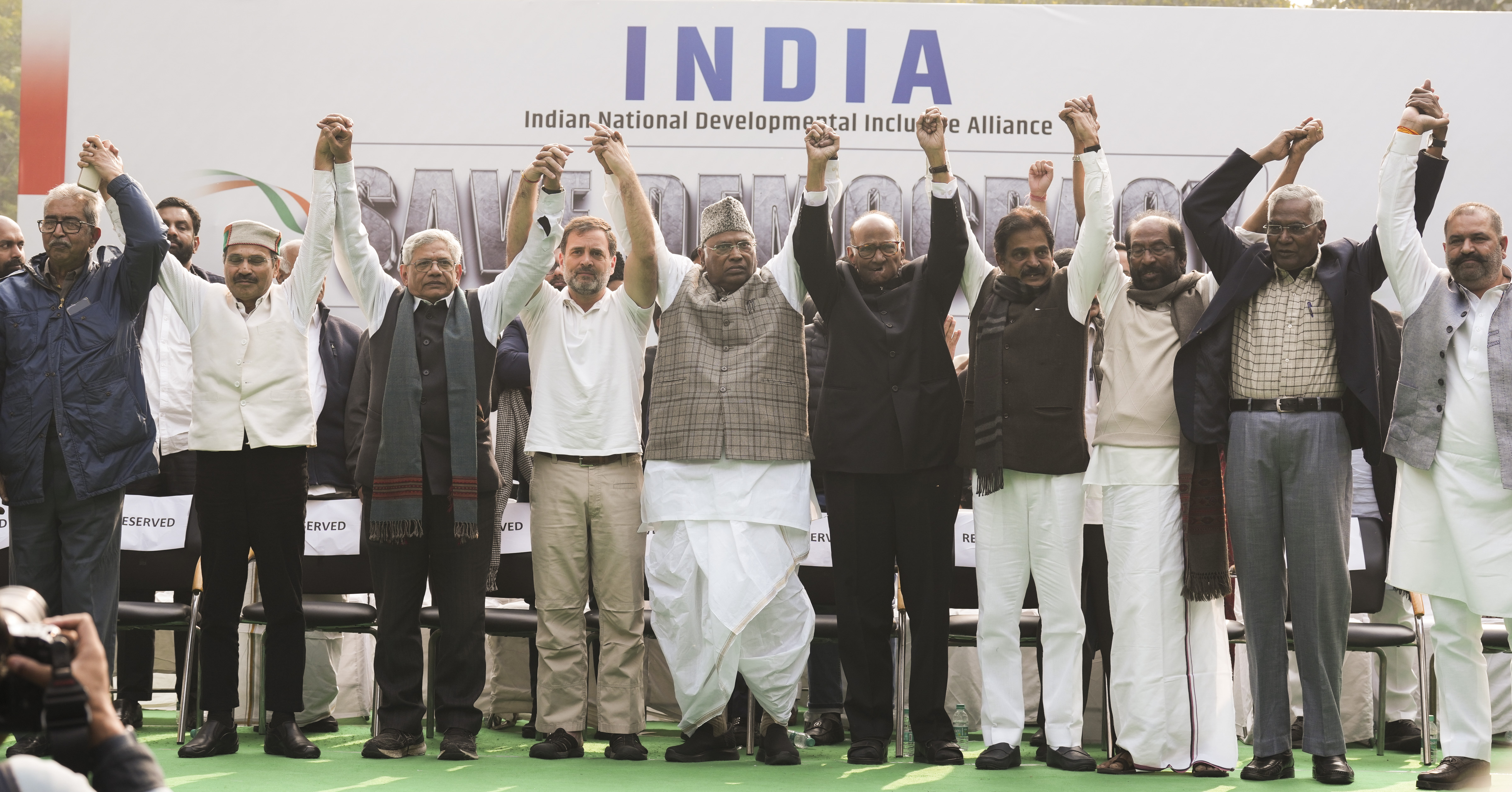In the past few years, Prime Minister Narendra Modi and his Bharatiya Janata Party (BJP) have had the world’s biggest democracy under their thumb. The BJP’s main opposition, the Indian National Congress (INC), has performed poorly in recent elections, which has been attributed in part to the absence of a strong leader. Other opposition parties have long remained too small and fragmented to collectively mount a challenge to the BJP. But now, an unexpected new opposition coalition is emerging. The “Indian National Developmental Inclusive Alliance” (INDIA) incorporates 26 parties, including the Indian National Congress (popularly known as Congress), regional powers, and emerging parties like the Aam Aadmi Party (AAP). While the presence of different parties from across India in the coalition suggests that Modi’s authority is not absolute, the substantial ideological differences among them, as well as the recent failures of the INC, cast doubt on its ability to succeed long-term.
Prior to this latest coalition, Congress led a much smaller coalition of left-leaning parties called the United Progressive Alliance (UPA). When the UPA coalition won the 2004 election, it consisted of 14 parties that gradually withdrew from the coalition over the next few years. By 2009, the UPA had been reduced to just five parties. Even other left-leaning and regional parties withdrew their support over issues such as India’s nuclear deal with the United States.
Today, Congress is still too weak to assert itself without a proper spokesman. Its reputation hangs by a thread as a result of corruption scandals and extensive backlash against the dynastic leadership of the Nehru-Gandhi family. While it has found its place within the INDIA coalition, neither Congress nor any other party is the bloc’s clear leader. There have already been conflicts between the various parties of the INDIA coalition—a development that is disheartening but not surprising given Congress’ strong left-leaning stance and the centrist position of the other major party, AAP.
Congress and the AAP are now hinting that they will challenge each other in upcoming elections in several states and constituencies. Congress spokespeople previously announced that the party will contest all seven Lok Sabha seats in Delhi, the AAP’s main stronghold. These claims have led to confusion and suspicion—so much so that the AAP initially threatened not to attend the coalition’s Mumbai meeting. Currently, they are fighting over Chandigarh’s Lok Sabha seat, with Congress requesting that the AAP bow out of the race for the seat that the AAP insists it will win. The seat-sharing arrangement of the two parties in Punjab and Delhi also remains an issue.
In addition to—or perhaps because of—these rivalries and ideological differences, the coalition doesn’t have a cohesive policy platform or strategy for the upcoming election. According to members like Rahul Gandhi, the former leader of the Congress who resigned after his dismal performance in the 2019 elections, the INDIA alliance could secure the country’s secularism and freedom given that “democratic institutions are under attack.” However, vague allusions to protecting democracy and helping “farmers and poor people” are no match for Modi’s clearly defined Hindu-centric nationalist policies.
Several opposition parties did come together in defense of former Congress leader Rahul Gandhi after the BJP orchestrated his arrest for defamatory claims made against the party. They collectively condemned the miscarriage of justice and stressed the importance of democratic principles. This was in many ways reminiscent of the formation of the Janata Alliance, when many parties united to defeat Indira Gandhi. However, Gandhi, having made extensive use of emergency powers, was a much more controversial figure than Modi is today, which made the upheaval of her government easier to execute. Even then, ideological differences ultimately kept the alliance from remaining in power for long, and it was soon defeated by Congress.
To be truly competitive, INDIA must make headway in its uphill battle to gain more seats in parliament. Part of the issue is in the sheer numbers. With general elections coming up in April 2024, INDIA must gain a simple majority in the Lok Sabha (the lower house of the Indian Parliament). The BJP, with 336 seats, currently holds an absolute majority in parliament. The alliance’s combined seat count only amounts to 143.
Congress’ latest plan has been to conduct a nationwide caste census and, based on results, increase the ceiling (currently 50 percent) of seats reserved for members of the backward castes. The idea isn’t without merit: If all parties in the coalition combine forces and target the 63 percent of India that doesn’t vote for Modi through strategies like the caste census to win the support of overlooked castes, the elections could be a close call. However, INDIA cannot rely on one blanket policy to reach millions of different people. The BJP outperforms them by effectively promising to unite all Hindus through its sharply defined agenda, which caters to a clear target demographic that also happens to be the majority of the Indian population (although of course not all Hindus vote for Modi, but enough for him to win).
For INDIA to pose a real threat to the BJP, it needs to come up with a concrete and effective policy platform and set aside existing ideological differences. It is going to take a lot more than mere talk of India’s democracy and minorities to achieve that. But if the coalition itself is as weak and divided as it is now, there is little chance that it will defeat Modi in the short run or even remain united in the long run. All it can hope to do is create a dent in the armor of India’s most powerful party. How big the dent will be remains to be seen.
